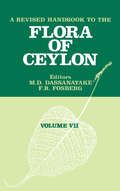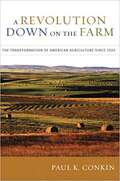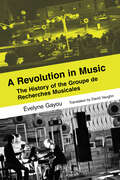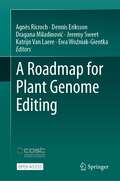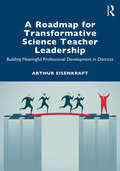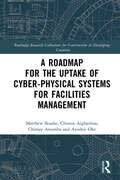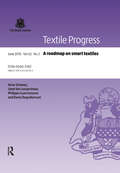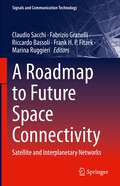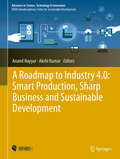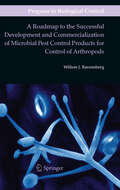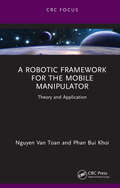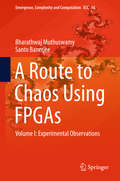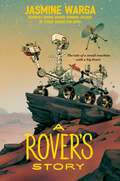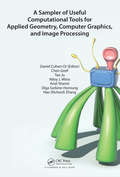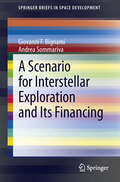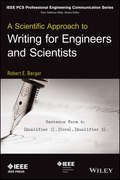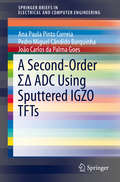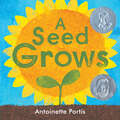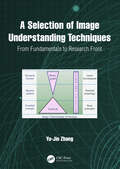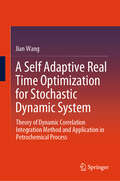- Table View
- List View
A Revised Handbook of the Flora of Ceylon - Volume 7
by M.D DassanayakeSeventh volume (in no planned sequence) of the revision of the works of Trimen, Alston, Abeywickrama. A worthy successor to a great and extremely scarce work. We lament that this revision is printed on acidic paper. Annotation copyright Book News, Inc. Portland, Or.
A Revolution Down On the Farm: The Transformation of American Agriculture Since 1929
by Paul K. ConkinAt a time when food is becoming increasingly scarce in many parts of the world and food prices are skyrocketing, no industry is more important than agriculture. Humans have been farming for thousands of years, and yet agriculture has undergone more fundamental changes in the past 80 years than in the previous several centuries. <p><p> In 1900, 30 million American farmers tilled the soil or tended livestock; today there are fewer than 4.5 million farmers who feed a population four times larger than it was at the beginning of the century. Fifty years ago, the planet could not have sustained a population of 6.5 billion; now, commercial and industrial agriculture ensure that millions will not die from starvation. Farmers are able to feed an exponentially growing planet because the greatest industrial revolution in history has occurred in agriculture since 1929, with U.S. farmers leading the way. Productivity on American farms has increased tenfold, even as most small farmers and tenants have been forced to find other work. <p><p> Today, only 300,000 farms produce approximately ninety percent of the total output, and overproduction, largely subsidized by government programs and policies, has become the hallmark of modern agriculture. <p><p> A Revolution Down on the Farm: The Transformation of American Agriculture since 1929 charts the profound changes in farming that have occurred during author Paul K. Conkin's lifetime. His personal experiences growing up on a small Tennessee farm complement compelling statistical data as he explores America's vast agricultural transformation and considers its social, political, and economic consequences. He examines the history of American agriculture, showing how New Deal innovations evolved into convoluted commodity programs following World War II. Conkin assesses the skills, new technologies, and government policies that helped transform farming in America and suggests how new legislation might affect farming in decades to come. <p><p> Although the increased production and mechanization of farming has been an economic success story for Americans, the costs are becoming increasingly apparent. Small farmers are put out of business when they cannot compete with giant, non-diversified corporate farms. Caged chickens and hogs in factory-like facilities or confined dairy cattle require massive amounts of chemicals and hormones ultimately ingested by consumers. Fertilizers, new organic chemicals, manure disposal, and genetically modified seeds have introduced environmental problems that are still being discovered. A Revolution Down on the Farm concludes with an evaluation of farming in the twenty-first century and a distinctive meditation on alternatives to our present large scale, mechanized, subsidized, and fossil fuel and chemically dependent system.
A Revolution in Music: The History of the Groupe de Recherches Musicales
by Évelyne GayouEstablished in the 1950s by musician and engineer Pierre Schaeffer, the Groupe de Recherches Musicales would become the nerve center for avant-garde artists experimenting with sound and acoustics, as well as the birthplace of a genre of music-making enabled by new recording technologies and sound pioneers: musique concrète. Évelyne Gayou—herself a researcher, composer, and producer at the GRM—tells the history of the storied institution through the people, works, technologies, and research developed there. Placing musique concrète within a broad historical context extending from the early twentieth-century avant-garde's experiments with noise to the development of techniques in sound recording (at the Studio d'Essai in the 1940s) and later in sound synthesis, Gayou shows how recording technology made it possible for composers to not only create music from sounds in the world around them but also create acousmatic music—novel sounds without a visible connection to their source. Available in English translation for the first time, this updated edition will be an important resource for readers interested in the pioneering works and techniques of Schaeffer and his contemporaries, as well as their influence on the makers of new music and the contemporary avant-garde.
A Roadmap for Plant Genome Editing
by Agnès Ricroch Jeremy Sweet Dennis Eriksson Dragana Miladinović Katrijn Van Laere Ewa Woźniak-GientkaThis open access book is an update of genome editing techniques applied to a range of plants. We discuss the latest techniques and applications to cereals, roots and tubers, oilseed crops, fruit and forest trees, vegetables, legumes and algae including resistance to biotic and abiotic stresses, improved quality, drug production, yield and adaptation to climate change. The regulations in different countries worldwide, the patentibility and the perception by society of the applications of new genomic techniques are examined. This book is written by a multidisciplinary and multisectoral collective of high-profile scientists and other experts belonging to the COST Action network PlantEd, which is mainly European but with contributions from American, Australian, Canadian, Chinese, Indian, Iranian, Pakistani and Peruvian scientists. The book is aimed at a wide audience consisting of students, academics, private and public breeders, other actors in the food and bioeconomy value chains and policy and law makers.This is an open access book.
A Roadmap for Transformative Science Teacher Leadership: Building Meaningful Professional Development in Districts
by Arthur EisenkraftThis book is a comprehensive guide to an effective Science Education Fellowship (SEF) program. Spanning more than ten years and involving hundreds of teachers, District Science Coordinators, and university faculty, the Wipro SEF program has empowered teachers to become leaders who drive meaningful, sustainable change in their schools and districts without leaving the classroom.Offering an in-depth look at the SEF program’s structure, from its foundation in teacher leadership development to its innovative adaptations across seven universities and 35 school districts; the book presents a roadmap for implementing similar programs in other school districts, targeting teacher retention, teacher development, and fostering student growth. Readers will find detailed explanations of key program components, and the vital roles of district science coordinators and higher education institutions. Through a mix of theoretical insights, practical strategies, and testimonials from program participants, the book provides a comprehensive model for educators, administrators, and university leaders who aspire to replicate or adapt the SEF program in their own contexts.Ideal for both educators and school administrators, this book will allow you to gain valuable insights into building and sustaining a program that empowers teacher-leaders, drives district-wide transformation, and ultimately improves student outcomes in science education.
A Roadmap for the Uptake of Cyber-Physical Systems for Facilities Management (Routledge Research Collections for Construction in Developing Countries)
by Clinton Aigbavboa Ayodeji Oke Matthew Ikuabe Chimay J AnumbaThis is the first book to conceptualise and develop a roadmap for the adoption of cyber-physical systems (CPS) for facilities management (FM) in developing countries. It is argued that effective use of CPS can help to significantly improve issues such as extended processing time, poor data acquisition, ineffective coverage of facility maintenance history, and poor-quality control within the facilities management sector. Through a theoretical review of relevant technology adoption models and frameworks, A Roadmap for the Uptake of Cyber-Physical Systems for Facilities Management provides a clear insight into the required parameters for integrating CPS into facilities management. The book will be beneficial to relevant stakeholders who face the responsibility of facilities and construction management as it contributes to the growing demand for the adoption of digital technologies in the delivery and management of built infrastructure. Furthermore, it serves as a solid theoretical base for researchers and academics in the quest to expand the existing borderline on construction digitalisation, especially in the post-occupancy stage.
A Roadmap on Smart Textiles
by Anne Schwarz Lieva Van Langenhove Philippe Guermonprez Denis DeguillemontIn order to stimulate the progress in smart textiles, emerging developments need to be identified and selectively strengthened. Hence, this issue reports on a three-dimensional roadmap on smart textiles. It aims at contributing to set future actions in research, education and technology development. Research activities and technological developments are mapped, barriers and drivers of technological, strategic and societal and economical origins are identified. Finally, recommendations are phrased on how to overcome barriers and to progress in the field of smart textiles.
A Roadmap to Future Space Connectivity: Satellite and Interplanetary Networks (Signals and Communication Technology)
by Frank H. P. Fitzek Marina Ruggieri Riccardo Bassoli Fabrizio Granelli Claudio SacchiThis book provides an overview of the latest R&D advancements in the field of ICT technologies inherent to a New Space vision. The book presents a system-level and technology-level description of future space networking and communications. The authors also expand the vision to interplanetary networks. The book spans hardware and software technologies for future space communication networks, also considering very modern paradigms like quantum technologies and Softwarization. In the book, the word “space” is intended in a wider sense than the usual “satellite communications”, including new and partially unexplored fields like quantum space communications, interplanetary communications, and extra-terrestrial Radio Access Networks (RANs). The book includes applications including Internet of Space Things, Tactile Internet/Digital twins for Space and discusses future challenges like those involved by the concept of “sustainable Space”.Provides an overview of the latest R&D advancements in the field of ICT technologies inherent to a New Space vision;Considers visions and perspectives of space technology, including a through overview of satellite communications;Presents a system-level overview of future space networking and communications.
A Roadmap to Industry 4.0: Smart Production, Sharp Business and Sustainable Development (Advances in Science, Technology & Innovation)
by Akshi Kumar Anand NayyarBusiness innovation and industrial intelligence are paving the way for a future in which smart factories, intelligent machines, networked processes and Big Data are combined to foster industrial growth. The maturity and growth of instrumentation, monitoring and automation as key technology drivers support Industry 4.0 as a viable, competent and actionable business model. This book offers a primer, helping readers understand this paradigm shift from industry 1.0 to industry 4.0. The focus is on grasping the necessary pre-conditions, development & technological aspects that conceptually describe this transformation, along with the practices, models and real-time experience needed to achieve sustainable smart manufacturing technologies. The primary goal is to address significant questions of what, how and why in this context, such as:What is Industry 4.0?What is the current status of its implementation?What are the pillars of Industry 4.0?How can Industry 4.0 be effectively implemented?How are firms exploiting the Internet of Things (IoT), Big Data and other emerging technologies to improve their production and services?How can the implementation of Industry 4.0 be accelerated?How is Industry 4.0 changing the workplace landscape?Why is this melding of the virtual and physical world needed for smart production engineering environments?Why is smart production a game-changing new form of product design and manufacturing?
A Roadmap to the Successful Development and Commercialization of Microbial Pest Control Products for Control of Arthropods (Progress in Biological Control #10)
by Willem J. RavensbergBiocontrol is among the most promising methods for a safe, environmentally benign and sustainable pest control. Microbial pesticides offer a great potential, and it is anticipated that they will become a substantial part of the use of all crop protection products. Their development and commercialization, however, has been difficult and with many failures. In this book a rational and structured roadmap has been designed for the development and commercialization of microbial pest control products for the control of arthropod pests. The building blocks of the entire process are identified and essential aspects highlighted. Biopesticides based on entomopathogenic bacteria, fungi, viruses and nematodes are elaborately discussed. This systematic roadmap with a strong focus on economics and market introduction will assist academic researchers and industrial developers of biopesticides in accomplishing their goal: the development of successful cost-effective microbial pesticides.
A Robotic Framework for the Mobile Manipulator: Theory and Application (Chapman & Hall/CRC Artificial Intelligence and Robotics Series)
by Nguyen Van Toan Phan Bui KhoiBy proposing and forming a mobile manipulator for modern multi-floor buildings, A Robotic Framework for the Mobile Manipulator: Theory and Application helps readers visualize an end-to-end workflow for making a robot system work in a targeted environment. From a product-oriented viewpoint, this book is considered as a bridge from theories to real products, in which robotic software modules and the robotic system integration are mainly concerned. In the end, readers will have an overview of how to build and integrate various single robotic modules to execute a list of designed tasks in the real world, as well as how to make a robot system work independently, without human interventions. With references and execution guidelines provided at the end of each chapter, the book will be a useful tool for developers and researchers looking to expand their knowledge about the robotics and the robotic software.
A Route to Chaos Using FPGAs: Volume I: Experimental Observations (Emergence, Complexity and Computation #16)
by Santo Banerjee Bharathwaj MuthuswamyThe purpose of this introductory book is to couple the teaching of chaotic circuit and systems theory with the use of field programmable gate arrays (FPGAs). As such, it differs from other texts on chaos: first, it puts emphasis on combining theoretical methods, simulation tools and physical realization to help the reader gain an intuitive understanding of the properties of chaotic systems. Second, the "medium" used for physical realization is the FPGA. These devices are massively parallel architectures that can be configured to realize a variety of logic functions. Hence, FPGAs can be configured to emulate systems of differential equations. Nevertheless maximizing the capabilities of an FPGA requires the user to understand the underlying hardware and also FPGA design software. This is achieved by the third distinctive feature of this book: a lab component in each chapter. Here, readers are asked to experiment with computer simulations and FPGA designs, to further their understanding of concepts covered in the book. This text is intended for graduate students in science and engineering interested in exploring implementation of nonlinear dynamical (chaotic) systems on FPGAs.
A Rover's Story
by Jasmine WargaNew York Times bestseller * Best Book of the Year from The Washington Post, Publishers Weekly, New York Public Library, Chicago Public LibraryThe One and Only Ivan meets The Wild Robot in this unique and deeply moving middle grade novel about the journey of a fictional Mars rover, from the Newbery Honor–winning author of Other Words for Home. Meet Resilience, a Mars rover determined to live up to his name.Res was built to explore Mars. He was not built to have human emotions. But as he learns new things from the NASA scientists who assemble him, he begins to develop humanlike feelings. Maybe there’s a problem with his programming….Human emotions or not, launch day comes, and Res blasts off to Mars, accompanied by a friendly drone helicopter named Fly. But Res quickly discovers that Mars is a dangerous place filled with dust storms and giant cliffs. As he navigates Mars’s difficult landscape, Res is tested in ways that go beyond space exploration.As millions of people back on Earth follow his progress, will Res have the determination, courage, and resilience to succeed… and survive?
A Sampler of Useful Computational Tools for Applied Geometry, Computer Graphics, and Image Processing
by Niloy J. Mitra Daniel Cohen-Or Chen Greif Tao Ju Olga Sorkine-Hornung Ariel Shamir Hao Richard ZhangA Sampler of Useful Computational Tools for Applied Geometry, Computer Graphics, and Image Processing shows how to use a collection of mathematical techniques to solve important problems in applied mathematics and computer science areas. The book discusses fundamental tools in analytical geometry and linear algebra. It covers a wide range of topics
A Scenario for Interstellar Exploration and Its Financing (SpringerBriefs in Space Development)
by Giovanni F. Bignami Andrea SommarivaThis book develops a credible scenario for interstellar exploration and colonization. In so doing, it examines: * the present situation and prospects for interstellar exploration technologies; * where to go: the search for habitable planets; * the motivations for space travel and colonization; * the financial mechanisms required to fund such enterprises. The final section of the book analyzes the uncertainties surrounding the presented scenario. The purpose of building a scenario is not only to pinpoint future events but also to highlight the uncertainties that may propel the future in different directions. Interstellar travel and colonization requires a civilization in which human beings see themselves as inhabitants of a single planet and in which global governance of these processes is conducted on a cooperative basis. The key question is, then, whether our present civilization is ready for such an endeavor, reflecting the fact that the critical uncertainties are political and cultural in nature. It is written in such a way as to allow the non-professional reader to become part of the debate on the future of space programs.
A Science Comic of Urban Metro Structure: Performance Evolution and Sensing Control
by Hehua ZhuThis science comic presents the entire life cycle of the metro system in an accessible and fun way. Just like human beings, a metro system can get sick, and this book introduces its ailments, medical records along with experts’ diagnoses and available treatments. Using cartoons, it enables readers of all levels to quickly understand the scientific secrets behind the metro system. It is based on the results of China’s 973 program, which aims to promote and develop basic scientific research in China.
A Scientific Approach to Writing for Engineers and Scientists (IEEE PCS Professional Engineering Communication Series)
by Robert E. BergerA SCIENTIFIC APPROACH TO WRITING Technical ideas may be solid or even groundbreaking, but if these ideas cannot be clearly communicated, reviewers of technical documents—e.g., proposals for research funding, articles submitted to scientific journals, and business plans to commercialize technology—are likely to reject the argument for advancing these ideas. The problem is that many engineers and scientists, entirely comfortable with the logic and principles of mathematics and science, treat writing as if it possesses none of these attributes. The absence of a systematic framework for writing often results in sentences that are difficult to follow or arguments that leave reviewers scratching their heads. This book fixes that problem by presenting a “scientific” approach to writing that mirrors the sensibilities of scientists and engineers, an approach based on an easily-discernable set of principles. Rather than merely stating rules for English grammar and composition, this book explains the reasons behind these rules and shows that good reasons can guide every writing decision. This resource is also well suited for the growing number of scientists and engineers in the U.S. and elsewhere who speak English as a second language, as well as for anyone else who just wants to be understood.
A Second-Order ΣΔ ADC Using Sputtered IGZO TFTs (SpringerBriefs in Electrical and Computer Engineering)
by Ana Paula Pinto Correia Pedro Miguel Cândido Barquinha João Carlos da Palma GoesThis books discusses the design, electrical simulation and layout of a 2nd-order ∑ analog-to-digital converter (ADC), using oxide thin-film transistors (TFTs) technology. The authors provide a unified view of materials science and electronics engineering, in order to guide readers from both fields through key topics. To accomplish this goal, background regarding materials, device physics, characterization techniques, circuit design and layout is given together with a detailed discussion of experimental data. The final simulation results clearly demonstrate the potential of the proposed circuit-level techniques, which enables the implementation of robust and energy efficient ADCs based on oxide TFTs, for moderate resolutions and conversion-rates.
A Seed Grows
by Antoinette PortisThe transformative life cycle of a sunflower plays out in this bold read-aloud by Sibert honoree Antoinette Portis. <p><p>To understand how a seed becomes a sunflower, you have to peek beneath the soil and wait patiently as winding roots grow, a stalk inches out of the earth, and new seeds emerge among blooming petals. <p><p>"A seed falls, And settles into the ground, And the Sun shines, And the rain comes down, And the seed grows…" Leading up to a striking fold-out spread of a full-grown sunflower, the lively, bold illustrations in A Seed Grows offer a close-up view of each step of the growth cycle. Additional material in the back of the book explains the science of plant life cycles, and goes into more detail on the ways in which flowers and seeds depend on other creatures. <P><P><i>Advisory: Bookshare has learned that this book offers only partial accessibility. We have kept it in the collection because it is useful for some of our members. Benetech is actively working on projects to improve accessibility issues such as these.</i>
A Selection of Image Understanding Techniques: From Fundamentals to Research Front
by Yu-Jin ZhangThis book offers a comprehensive introduction to seven commonly used image understanding techniques in modern information technology. Readers of various levels can find suitable techniques to solve their practical problems and discover the latest development in these specific domains.The techniques covered include camera model and calibration, stereo vision, generalized matching, scene analysis and semantic interpretation, multi-sensor image information fusion, content-based visual information retrieval, and understanding spatial-temporal behavior. The book provides aspects from the essential concepts overview and basic principles to detailed introduction, explanation of the current methods and their practical techniques. It also presents discussions on the research trends and latest results in conjunction with new development of technical methods. This is an excellent read for those who do not have a subject background in image technology but need to use these techniques to complete specific tasks. These essential information will also be useful for their further study in the relevant fields.
A Self Adaptive Real Time Optimization for Stochastic Dynamic System: Theory of Dynamic Correlation Integration Method and Application in Petrochemical Process
by Jian WangThis book introduces a real-time optimization (RTO) method based on the dynamic correlation integration (DCI) theory, which has the performances of modeling-free and self-adaptive model changes in real process. With this method, the implementation of RTO could be simplified in great deal comparing to traditional modeling way in many cases, and it especially benefits to the RTO of complex chemical reactions and the processes which are difficult to modeling. This book is applicable to real-time optimization theory researchers and practical application engineers for reference.
A Sense of Place: An Intimate Portrait of the Niebaum-Coppola Winery and the Napa Valley
by Steven KolpanIn A Sense of Place, renowned wine expert and writer Steven Kolpan tells the story of how Francis Ford Coppola brought California's most distinguished and historic vineyard back to life. Gustave Niebaum's Inglenook Estate, started in 1879, was one of the Napa Valley's first established vineyards and the birthplace of its premium wine industry. Generations after Niebaum's death, the vineyard was sold to Heublein, the wine and spirits monolith, who broke up the land and changed the Inglenook brand from a premium, connoisseur wine to a mass-market jug wine. In 1975, Francis Coppola bought the Niebaum residence and the surrounding estate. Along with the original estate's reputation, he also brought back some of its original workers, including Rafael Rodriquez, who, in h is late seventies, now serves as the vineyard manager and historian. Coppola overcame naysayers, red tape, and financial turmoil to reestablish the winery as a defender of quality, producing wine under four different labels, including the revered wine Rubicon. In 1995, Coppola purchased the Inglenook Chateau and its adjacent vineyards, fulfilling his dream of reuniting the original Napa Valley estate. Kolpan's luscious, flavorful narrative is worth enjoying now and keeping for later.
A Sensory Approach to STEAM Teaching and Learning: Materials-Based Units for Students K-6
by Kerry P. Holmes Jerilou J. Moore Stacy V. HolmesDid you know you have the power and the materials at your fingertips to facilitate the actual brain growth of students? This book is a practical resource to engage K-6 students with STEAM content through their five senses: seeing, listening, touch/movement, smell and taste. It combines historical research, practical suggestions, and current practices on the stages of cognitive development and the brain’s physical response to emotion and novelty; to help you learn ways to transform ordinary lesson plans into novel and exciting opportunities for students to learn through instruction, exploration, inquiry, and discovery. In addition to providing examples of sensory-rich unit plans, the authors take you through the step-by-step process on how to plan a thematic unit and break it down into daily seamless lesson plans that integrate science, technology, engineering, arts, and mathematics. With 25 themed STEAM unit plans and activities based on national standards, up-to-date research on brain science, and real classroom experience, this book shows multiple ways to develop and deliver active multisensory activities and wow your students with sights and sounds as soon as they come through the door of your classroom.
A Sensory Approach to STEAM Teaching and Learning: Materials-Based Units for Students K-6
by Kerry P. Holmes Jerilou J. Moore Stacy V. HolmesDid you know you have the power and the materials at your fingertips to facilitate the actual brain growth of students?This book is a practical resource to engage K-6 students with STEAM content through their five senses: seeing, listening, touch/movement, smell and taste. It combines historical research, practical suggestions, and current practices on the stages of cognitive development and the brain’s physical response to emotion and novelty; to help you learn ways to transform ordinary lesson plans into novel and exciting opportunities for students to learn through instruction, exploration, inquiry, and discovery.In addition to providing examples of sensory-rich unit plans, the authors take you through the step-by-step process on how to plan a thematic unit and break it down into daily seamless lesson plans that integrate science, technology, engineering, arts, and mathematics.With 25 themed STEAM unit plans and activities based on national standards, up-to-date research on brain science, and real classroom experience, this book shows multiple ways to develop and deliver active multisensory activities and wow your students with sights and sounds as soon as they come through the door of your classroom.
A Shift in the Security Paradigm: Global Challenges: Is Europe Ready to Meet Them? (Advanced Sciences and Technologies for Security Applications)
by J. Martín Ramírez Jerzy BiziewskiThis book discusses some of the strategic lines in front of the trends related to the new challenges of global security in this new century: some rather universal problems (migration, terrorism, cyberspace, conflict resolutions techniques in prisons, economic intelligence), as well as more military ones (new conflicts: new world stage, new weapons, new military doctrines, mass destruction weapons and nuclear arms control, outer space and ocean depths), without forgetting some global and conceptual topics (disintegration is driving insecurity, searching for quality in international affairs, shield of security culture through data protection, information society and the protective influence of security culture). A special focus is put on Europe's interests. The unique, complex process of integration of European states is confronted by various problems caused by the implementation of different political visions presented by the factions of the European Union's establishment. The diverse interpretation of the goals and paths of development of this organization leads to the violation of its cohesion, which is used by global partners with the opportunity to broaden their influence and achieve their own goals by playing European countries individually. There is a need for the EU to go further to achieve a deeper level of integration and strategic autonomy which would allow for the implementation of a coherent policy towards the powers.
